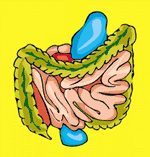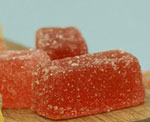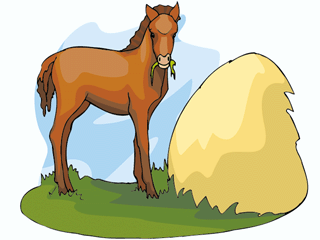The Hydrometer
Determines the Specific Gravity of Liquids
"Testing apple juice and potential vinegar strength is a snap!"
The hydrometer, invented in the early eighteenth century, is a simple floating device calibrated to measures the specific gravity or density of a liquid. It is readily available at your local home brew shop, is inexpensive and has several important vinegar making uses.
If you are making apple cider vinegar from apple juice, this test unit can be used to determine the amount of sugar in the juice and the potential amount of alcohol you will get by completely fermenting that apple juice to hard cider.
After completion of the hard cider, you can determine the actual amount of alcohol present and from this value you will know the maximum strength of vinegar you can obtain from this hard apple cider.

The hydrometer is a sealed, hand blown glass tube, which contains lead shot in the bottom and several calibrated scales in the upper stem. (One scale for specific gravity, one for potential alcohol and one for sugar content.) It is used with a tall cylindrical testing jar, which holds the liquid to be tested.
Once the testing jar is filled with juice and the glass tube inserted, it will sink to a level determined by the density of the sample, which is related to the amount of soluble solids (mostly sugar) contained in the juice.
The Hydrometer Test Procedure
Fill the test jar three-quarters full with apple juice or apple cider then slowly insert the hydrometer.
Spin it in the liquid to dislodge any air bubbles clinging to the glass, which could cause a test error.
-
At eye level, read the specific gravity figures on the glass stem where the surface of the liquid cuts across it.
Since many home brew testers only give accurate readings when the temperature of the test liquid is at 60 F (16 C), measure the temperature of the test liquid and use the following table to correct for temperature differences:
Correction for Specific Gravity
| Temperature in degrees F |
Temperature in degrees C |
Correction Factor |
| 60 | 16 | None |
| 70 | 21 | Add 0.001 |
| 77 | 25 | Add 0.002 |
| 84 | 29 | Add 0.003 |
| 95 | 35 | Add 0.005 |
| 105 | 41 | Add 0.007 |
For example, if on a hot summer day your apple juice reads 1.036 on the specific gravity scale and the temperature of the juice is 95 degrees F (35 C) then the correct specific gravity would be: 1.036 + 0.005 = 1.041.
Using the Hydrometer to Determine
Sugar Content and Potential Alcohol Content
in an Apple Juice
The hydrometer can be used to determine the actual sugar content and the potential alcohol content in all types of fruit juices including apple juice.
In 1843, a Balling density scale was developed by a German chemist Karl Balling. He designed the scale so that each degree Balling would be equivalent to 1% sugar content (by weight) in pure water at a temperature of 17.5 degrees C.
Since apple juice and other fruit juices are basically sugar water solutions, the Balling reading gives the percentage of sugar (sucrose, fructose & glucose) present in the juice.
In 1897 Dr. A Brix, an Austrian, corrected some errors and recalculated Balling's scale to a reference temperature of 15.5 degrees C. The Brix density scale was later recalculated to a reference temperature of 20 degrees C.
The Balling and Brix scales are often used interchangeably since the differences are minor.
An apple juice which measures 12 degrees on the Balling or Brix scale contains about 12% sugar by weight.
Multiplying the Brix value by 0.56 will give the potential alcohol content (% by volume) that the juice would have if the sugar was completely fermented to alcohol.
If your hydrometer does not have a brix or potential alcohol scale, then you can use the following table to convert your juices specific gravity to degrees Brix and potential alcohol content.
Note: The table specific gravity values are taken at 20 degrees C.
Ref.: USDA Technical Inspection Procedures-Brix Measurement
Conversion Table
Specific Gravity to Brix and Potential Alcohol Content
| Specific Gravity @20 degrees C |
Brix degrees |
Potential Alcohol Content % by volume |
| 1.000 | 0 | 0 |
| 1.001 | 0.26 | 0.15 |
| 1.002 | 0.51 | 0.29 |
| 1.003 | 0.77 | 0.44 |
| 1.004 | 1.03 | 0.58 |
| 1.005 | 1.28 | 0.72 |
| 1.006 | 1.54 | 0.87 |
| 1.007 | 1.80 | 1.01 |
| 1.008 | 2.05 | 1.15 |
| 1.009 | 2.31 | 1.30 |
| 1.010 | 2.56 | 1.44 |
| 1.011 | 2.81 | 1.58 |
| 1.012 | 3.07 | 1.72 |
| 1.013 | 3.32 | 1.86 |
| 1.014 | 3.57 | 2.00 |
| 1.015 | 3.82 | 2.14 |
| 1.016 | 4.08 | 2.28 |
| 1.017 | 4.33 | 2.42 |
| 1.018 | 4.58 | 2.56 |
| 1.019 | 4.83 | 2.70 |
| 1.020 | 5.08 | 2.84 |
| 1.021 | 5.33 | 2.98 |
| 1.022 | 5.57 | 3.10 |
| 1.023 | 5.82 | 3.25 |
| 1.024 | 6.07 | 3.39 |
| 1.025 | 6.32 | 3.53 |
| 1.026 | 6.57 | 3.67 |
| 1.027 | 6.81 | 3.80 |
| 1.028 | 7.06 | 3.94 |
| 1.029 | 7.30 | 4.08 |
| 1.030 | 7.55 | 4.22 |
| 1.031 | 7.80 | 4.35 |
| 1.032 | 8.04 | 4.49 |
| 1.033 | 8.28 | 4.62 |
| 1.034 | 8.53 | 4.76 |
| 1.035 | 8.77 | 4.89 |
| 1.036 | 9.01 | 5.03 |
| 1.037 | 9.26 | 5.17 |
| 1.038 | 9.50 | 5.30 |
| 1.039 | 9.74 | 5.44 |
| 1.040 | 9.98 | 5.57 |
| 1.041 | 10.22 | 5.70 |
| 1.042 | 10.46 | 5.84 |
| 1.043 | 10.70 | 5.97 |
| 1.044 | 10.94 | 6.10 |
| 1.045 | 11.18 | 6.24 |
| 1.046 | 11.42 | 6.37 |
| 1.047 | 11.66 | 6.50 |
| 1.048 | 11.90 | 6.64 |
| 1.049 | 12.14 | 6.77 |
| 1.050 | 12.37 | 6.90 |
| 1.051 | 12.61 | 7.03 |
| 1.052 | 12.85 | 7.17 |
| 1.053 | 13.08 | 7.30 |
| 1.054 | 13.32 | 7.43 |
| 1.055 | 13.55 | 7.56 |
| 1.056 | 13.79 | 7.69 |
| 1.057 | 14.02 | 7.82 |
| 1.058 | 14.62 | 7.95 |
| 1.059 | 14.49 | 8.08 |
| 1.060 | 14.96 | 8.21 |
Click here to see a hydrometer being used to measure the sugar content of an apple juice in this short You Tube video.






